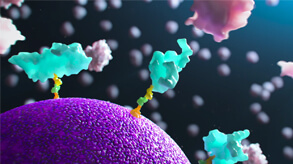Plasma proteins reveal molecular signatures of aging and frailty
The mechanisms of aging are not well understood. While the genome is largely unchanged with age, recent studies offer a glimpse into the proteomic changes that occur in our bodies with time, providing insight into the development of chronic disease and frailty associated with aging.
Compared to genomic studies, which have become commonplace over the last few decades, proteomic studies have been much more limited, largely due to the difficulty of simultaneously measuring multiple proteins over a range of concentrations. Studying protein expression can provide a comprehensive picture of health, provide new insight into the mechanisms of aging-related disease, and suggest interventions based on the early signs of disease development.
Two recent studies using the SomaScan® Assay demonstrate what massive scale proteomics can teach us about aging. The SomaScan Assay is a highly multiplexed, sensitive and reproducible proteomics tool that can measure 7,000 proteins simultaneously from a single blood sample. By looking at the blood plasma levels of a broad protein profile in a diverse cohort of participants, scientists were able to uncover molecular signatures associated with particular life stages and predict accelerated aging and disease development, as well as identify factors that contribute to frailty in elderly patients.
Plasma proteome reveals biomarkers of age and age-related disease
The first study by a Stanford University group was published at the end of 2019 in Nature Medicine and looked for general markers of aging by analyzing proteins from the blood plasma of 4,263 adults ranging from 18 to 90+ years old. Plasma contains protein biomarkers indicative of the state of different organs and tissues, which suggests that age-related molecular changes in blood could identify links between aging and disease. Indeed, there was a strong association between patterns of protein expression and age-related diseases such as Alzheimer’s disease and cardiovascular disease. Adjusting for other factors, the presence of protein signatures associated with these conditions was indicative of accelerated aging. Further investigation could help determine whether these associations reveal causal mechanisms of disease.
The largest shifts in proteome composition occur at pivotal age crests
The study’s lead investigator, Dr. Benoit Lehallier, and colleagues were surprised to see that dramatic changes in protein expression profiles happened in stages, rather than gradually. These crests appeared around the age of 34, 60 and 78, when significant changes occurred in clusters of proteins, particularly related to cellular signaling. Moreover, protein clusters characteristic of middle and old age overlapped with proteins associated with cognitive and physical impairments. These proteins were also enriched in patients with Alzheimer’s, Down syndrome, and cardiovascular disease (controlling for age and other confounding factors), which are associated with accelerated aging.
Protein signatures can be used to predict biological age
To determine whether the plasma proteome can serve as a ‘proteomic clock’, data from 2,817 individuals were used to train a predictive model that was then tested on the remaining 1,446. Subsequent analysis identified 373 proteins that could be used to predict age. Interestingly, individuals who were predicted to be younger than their chronological age also performed better on cognitive and physical tests. Researchers then added genetic data to see if these differences could be explained by genes. However, genetically based sources of variation in plasma protein profiles became less prominent with age, instead becoming dominated by signatures associated with disease and aging. These results suggest that environmental factors and the presence of disease start playing a bigger role on physiological function as people age.
Proteomic scan identifies pathways linked to frailty
The second study from the Institute for Aging Research at Albert Einstein College of Medicine came out in Aging Cell this August and focused on analyzing the complex phenotype of frailty. Frailty describes a combination of physical, psychological and cognitive factors which make patients more vulnerable to adverse outcomes in aging. It is characterized by dysregulation across multiple pathways. Previous studies have used genetic and proteomic approaches to try to understand the biology of frailty, but the results were largely inconclusive due to the small number of proteins analyzed and the group sample size. Here researchers used the SomaScan Assay to look at plasma samples of 880 community‐residing Ashkenazi Jewish older adults.
The researchers wanted to identify specific signatures of frailty that are distinct from general markers of aging. They examined expression of 4,265 plasma proteins and found 143 associate markers, including 88 that were enriched in people exhibiting phenotypic signs of frailty. These were predominantly proteins related to lipid metabolism, musculoskeletal development and function, cell‐to‐cell signaling, and cellular assembly and organization. Interestingly, the proteins most strongly associated with frailty were fatty acid‐binding proteins. The top two hits (H‐FABP and FABPA) are known biomarkers of cardiac disease and metabolic syndrome. The third one, leptin, is also correlated with obesity and cardiovascular disease.
This study also developed a predictive model based on 110 proteins. The model showed a correlation between predicted and observed frailty, although the association was relatively weak (R = 0.57, p < 2.2 × 10−16). In fact, predicted frailty more strongly correlated with chronological age than observed frailty, indicating that the two are intertwined and require further investigation to untangle. Overall, the study identified proteins and pathways that may help frailty phenotyping and prediction.
Conclusion
The study of aging is complicated by large variations across genetic backgrounds, along with environmental, socioeconomic and other factors that, when combined, generate a vast number of interplaying components that contribute to phenotypic outcomes. Proteomic studies can help elucidate the underlying mechanisms of aging and disease by finding patterns among millions of protein measurements. This data could potentially be used to develop translational interventions to counteract the effects of age-related ailments. Additionally, signatures in the plasma proteome can improve prognostic and diagnostic tests. To learn more, watch this webinar recording where the authors of the Nature Medicine paper discuss their findings.
References
- Lehallier, Benoit, et al. “Undulating changes in human plasma proteome profiles across the lifespan.” Nature medicine 25.12 (2019): 1843-1850.
- Sathyan, Sanish, et al. “Plasma proteomic profile of frailty.” Aging Cell: e13193.
More blogs
BlogHow Blood Proteomics Is Accelerating Neuro Drug Discovery
Explore how researchers are using blood-based proteomics – including data from the Global Neurodegeneration Proteomics Consortium (GNPC) – to uncover new protein signatures, genetic risk associations and mechanistic insights into aging and neurodegeneration.
BlogGNPC Neurodegeneration Proteomics Dataset
On July 15, 2025, the Global Neurodegeneration Proteomics Consortium (GNPC) published four open‑access papers unveiling the largest disease‑specific proteomic resource ever assembled.
BlogIndependent study validates the SomaScan Assay as the most precise and comprehensive plasma proteomic platform
A recent independent study by Alkahest, published as a preprint on bioRxiv1, compared the technical precision and performance of multiple plasma proteomic platforms using a common set of samples.





